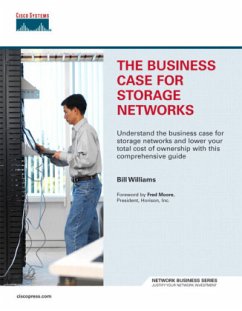Understand the business case for storage networks and lower your total cost of ownership with this comprehensive guide
Introduces the benefits of storage networks, providing a comprehensive business case for the adoption and deployment of storage networking solutions
Provides a complete overview of the TCO methodology for storage networks
Summarizes the EVA, NPV, and ROI metrics used to evaluate projects, ensuring their financial success
Outlines the best practices for executing a storage migration strategy
Includes a TCO calculator and decision-making checklist that you can use to assess your decision
When adopting a storage networking solution, you need to understand the business case for your decision. Yet this process is fraught with many business and technical considerations. How will the adoption of a storage networking solution affect your current infrastructure? How will your IT team grapple with the addition of a new technology? How can you turn the cost of your storage network into a business benefit, strengthening your bottom line and paving the way for future success?
Storage networking technologies promise a high return on investment (ROI) and have the potential to reduce the cost of corporate IT functions, which can result in significant savings. The increased efficiency associated with networked storage also promises a lower total cost of ownership (TCO) for storage, and a lower, fully burdened cost of storage means greater long-term savings for large and small corporate datacenter environments. SAN technologies also offer increased business continuance capabilities for increased uptime and availability.
The Business Case for Storage Networks covers the problem of direct-attached storage (DAS) and the solutions offered by storage area networks. It details the experiences of IT decision makers and implementers who have deployed SAN solutions to address the formidable problems facing their companies, which are now overwhelmed with expensive, inefficient, and difficult-to-manage DAS solutions. The Business Case for Storage Networks addresses the problems of storage growth and increased consumption, the role of the IT department as a cost center, and how SAN technologies can help save money in the long run, helping you make an informed decision about your storage networking investment.
This volume is in the Network Business Series offered by Cisco Press. Books in this series provide IT executives, decision makers, and networking professionals with pertinent information on today's most important technologies and business strategies.
Introduces the benefits of storage networks, providing a comprehensive business case for the adoption and deployment of storage networking solutions
Provides a complete overview of the TCO methodology for storage networks
Summarizes the EVA, NPV, and ROI metrics used to evaluate projects, ensuring their financial success
Outlines the best practices for executing a storage migration strategy
Includes a TCO calculator and decision-making checklist that you can use to assess your decision
When adopting a storage networking solution, you need to understand the business case for your decision. Yet this process is fraught with many business and technical considerations. How will the adoption of a storage networking solution affect your current infrastructure? How will your IT team grapple with the addition of a new technology? How can you turn the cost of your storage network into a business benefit, strengthening your bottom line and paving the way for future success?
Storage networking technologies promise a high return on investment (ROI) and have the potential to reduce the cost of corporate IT functions, which can result in significant savings. The increased efficiency associated with networked storage also promises a lower total cost of ownership (TCO) for storage, and a lower, fully burdened cost of storage means greater long-term savings for large and small corporate datacenter environments. SAN technologies also offer increased business continuance capabilities for increased uptime and availability.
The Business Case for Storage Networks covers the problem of direct-attached storage (DAS) and the solutions offered by storage area networks. It details the experiences of IT decision makers and implementers who have deployed SAN solutions to address the formidable problems facing their companies, which are now overwhelmed with expensive, inefficient, and difficult-to-manage DAS solutions. The Business Case for Storage Networks addresses the problems of storage growth and increased consumption, the role of the IT department as a cost center, and how SAN technologies can help save money in the long run, helping you make an informed decision about your storage networking investment.
This volume is in the Network Business Series offered by Cisco Press. Books in this series provide IT executives, decision makers, and networking professionals with pertinent information on today's most important technologies and business strategies.








